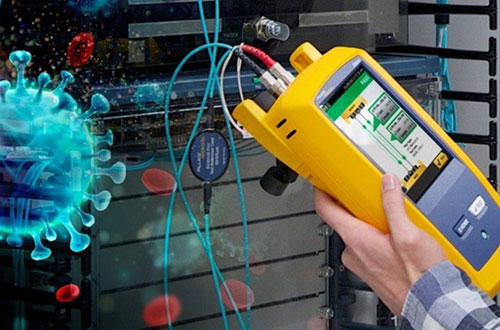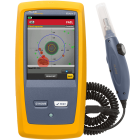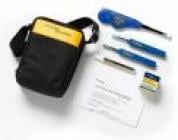How to clean your cable and fiber network tester
June 11, 2021 / General, 101 learning, Installation and testing, Best Practices
Cleanliness has long been a best practice in fiber optic installation, but it’s not just the fiber end faces you need to worry about. If you think about how often your cabling tools and testers are touched by you and others on the job site, it’s clear that they too need to be cleaned.
While a fiber end face and your Fluke Network tester are cleaned for two different reasons, the goal in both instances is to clean without causing any damage.

Cleaning your network tester
Cleaning your Fluke Networks’ tools and testers is important to keeping everyone in your workplace safe and healthy.
When it comes to cleaning your test equipment, you can use isopropyl alcohol., but beware of the alcohol percentage. While a concentration of 80% may be okay for hand sanitizer, it’s not recommended to use an isopropyl alcohol concentration of more than 70% as it may damage the markings or screen on your tester. Also always avoid using any type of acetone as it can dissolve plastics. Fluke also offers meter cleaning wipes, but these should be avoided for everyday cleaning and not used on the LCD screen. Using a 3% hydrogen peroxide solution is a great option for everyday tester cleaning.
Never use an abrasive cleaner on your tester, especially when cleaning the screen as it can leave behind scratches that can make it difficult to clearly see your test results—especially in dimly lit spaces. When cleaning the screen, we recommend using a microfiber cloth much like you’d use to clean your smartphone or eyeglasses. Commercial lens cleaner works great for this. Just be sure to use a fresh cloth each time and don’t rub it dry. Let the screen air dry and make sure the cleaner evaporates quickly and leaves no residue.
Cleaning OTDR ports
Dirty ports are very common on fiber optic testers – in fact, most testers coming in for service require port cleaning. A dirty port on your tester will cause poor results but note that cleaning the actual test port needs to follow recommendations for end face cleaning—not those for surface cleaning of the tester itself. The simplest method to clean your test ports is to use Quick Clean™ cleaners. If contamination is heavy, you can use a swab dampened with Fluke Networks Cleaning Solvent and follow with a dry swab. To avoid getting too much solvent in the port, touch the solvent pen to a fiber cleaning card or cube, then touch the swab to that spot. You should also inspect the port just to make sure it’s really clean. Thankfully, dirty ports will generate a warning message when you’re using the CertiFiber Pro or OptiFiber Pro. Learn more about cleaning the ports in these knowledge base articles:
- How to clean your OptiFiber® Pro Output Ports are clean
- How to clean your CertiFiber Pro® Output Ports
Cleaning end faces
When looking at your end faces, follow the golden rule of inspect, clean, and inspect again. After all, fiber end face contamination remains the number one of cause of fiber network issues. For more information about when to use pen-type cleaners like the Quick Clean cleaners, or when stubborn contaminants need wet cleaning, read the article detailing how to clean fiber cables properly: Golden Rule of Fiber Inspection - Clean and Inspect Again.
And when you’re done cleaning, don’t forget to inspect the end face again—it takes just over a second for a Fluke Networks’ FI-7000 FiberInspector Pro to certify fiber end faces to the IEC 61300-3-35 standards.
See Inspection & Cleaning products







